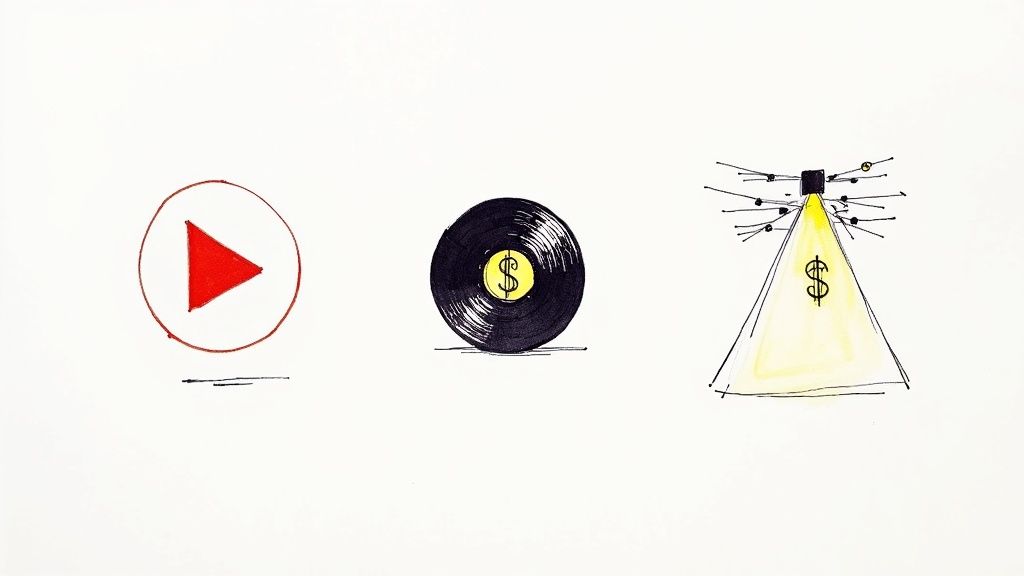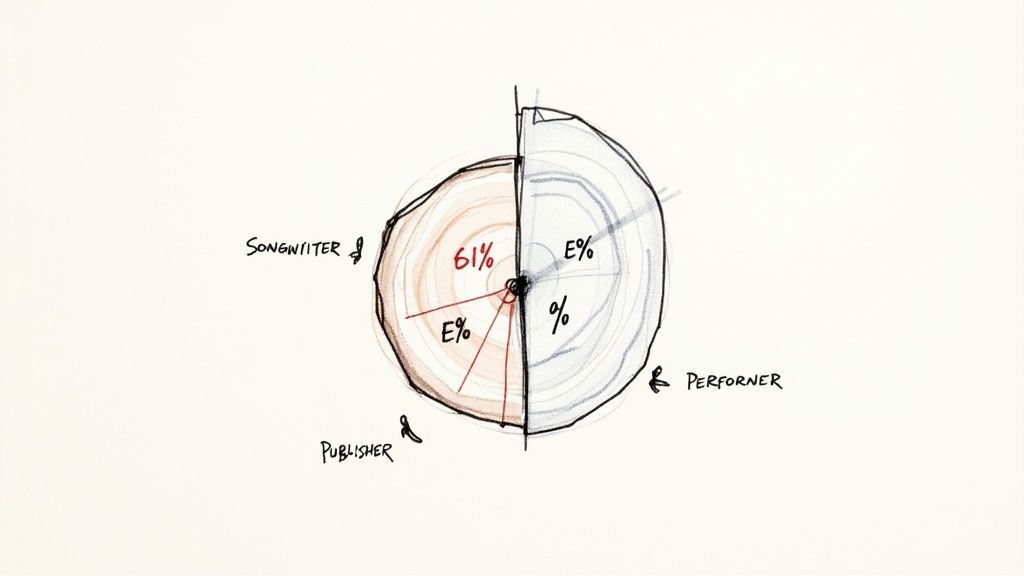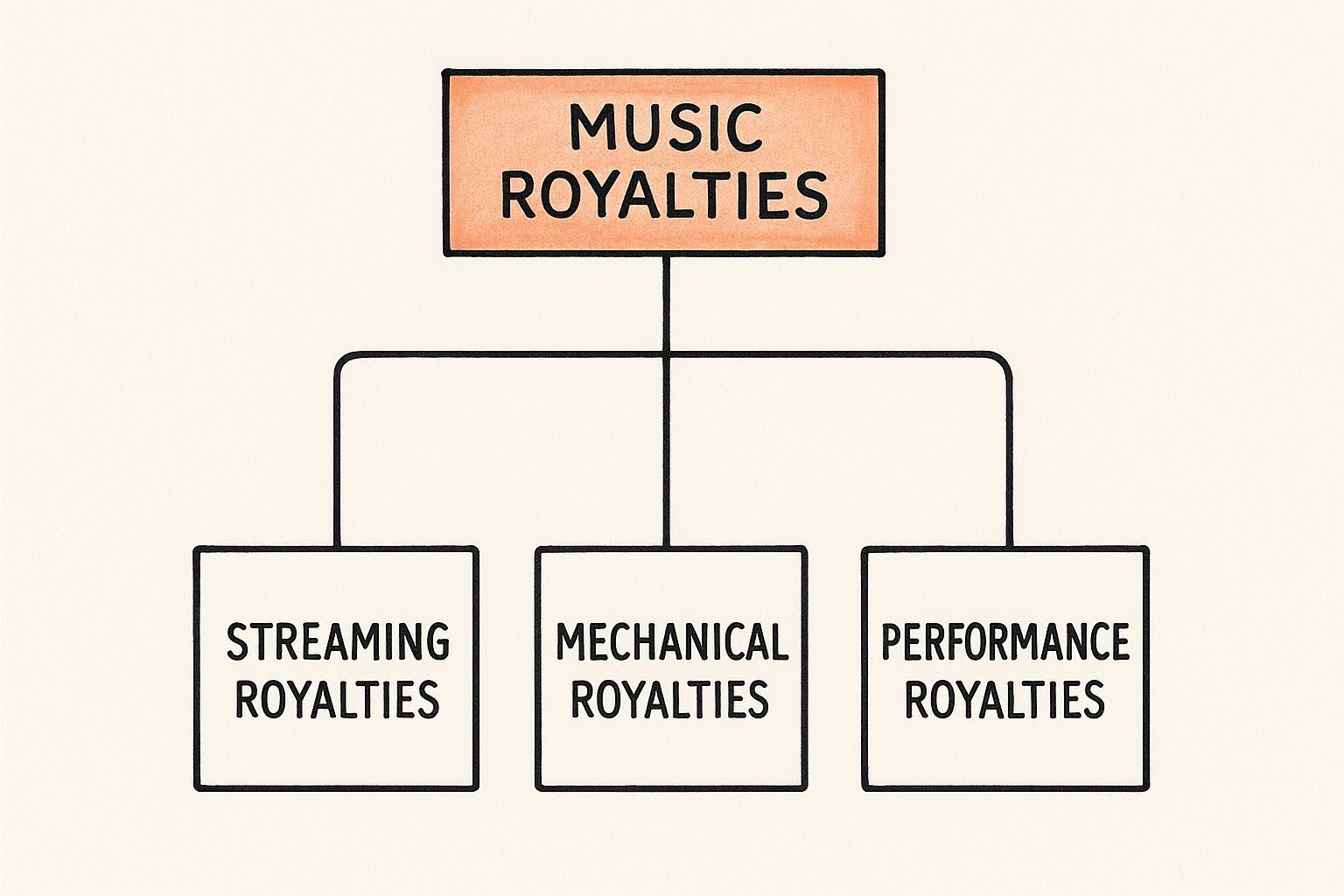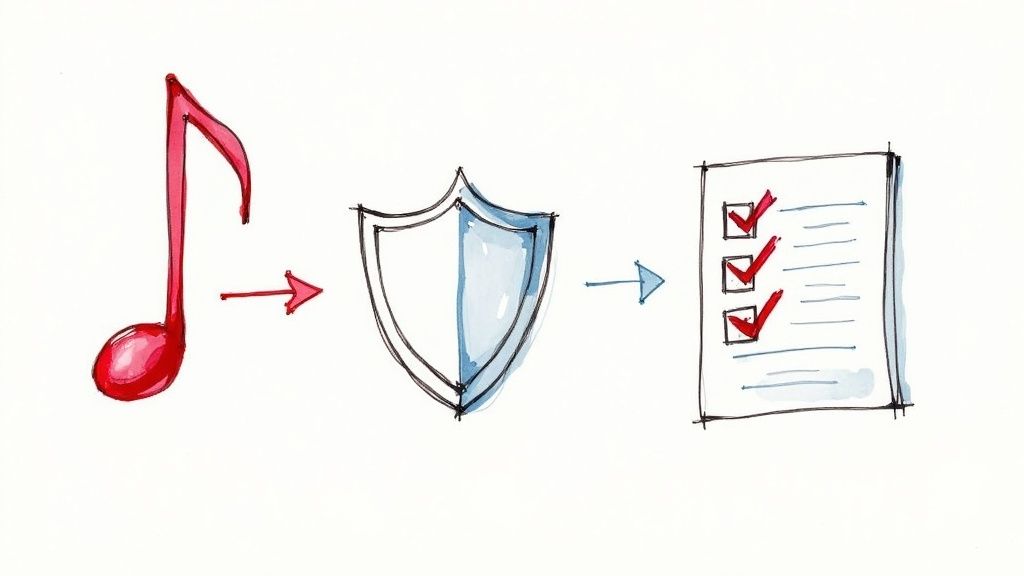What Are Royalties in the Music Industry? Essential Guide
- cinane4399
- Aug 25
- 14 min read
So, you’ve poured your heart and soul into creating a killer track. Now what? Understanding how you get paid for that hard work is the single most important step in turning your passion into a sustainable career. This is where music royalties come in.
Think of your song like a piece of property. Every time someone wants to use it—whether they stream it, play it on the radio, or drop it into a movie scene—they have to pay rent to you, the owner. That "rent" is what we call a royalty.
Your Guide to How Music Royalties Work

Getting a handle on royalties isn't just about chasing a paycheck; it's about knowing the true value of what you create. If you don't understand how the money flows, you're essentially working for free and leaving cash on the table that is rightfully yours.
The system might seem complicated at first glance, but the core idea is simple: creators deserve to be paid when their work is used. This guide will cut through the confusing jargon and show you exactly how it all works, breaking down each income stream one by one.
The Four Pillars of Music Royalties
To get started, it helps to know the main ways you can earn money from your music. Each one is triggered by a different type of use and flows through different channels.
There are four primary types you need to know:
Mechanical Royalties: These are generated anytime your song is reproduced. Think physical copies like CDs and vinyl, but also digital downloads and, yes, every single stream on platforms like Spotify.
Performance Royalties: You earn these whenever your song is performed publicly. That includes plays on the radio, in a restaurant or bar, at a live show, or on streaming services.
Synchronization (Sync) Royalties: This is the money you make when your song is licensed for use with visual media. We're talking about movies, TV shows, commercials, and video games.
Digital Performance Royalties: This is a special kind of performance royalty paid for "non-interactive" digital plays, like on internet radio services such as Pandora or SiriusXM, where the listener doesn't choose the specific song.
To make this even clearer, here's a quick breakdown of these core royalty streams.
Quick Overview of Key Music Royalty Types
Royalty Type | Who Gets Paid | Generated When... |
|---|---|---|
Mechanical | Songwriters & Publishers | A song is reproduced (physical sales, digital downloads, streams). |
Performance | Songwriters & Publishers | A song is performed publicly (radio, TV, live venues, streams). |
Synchronization | Songwriters, Publishers, & Master Owners | A song is licensed for use in visual media (films, TV, ads). |
Digital Performance | Recording Artists & Master Owners | A song is played on non-interactive digital radio (e.g., Pandora). |
Each one of these categories represents a distinct path to getting paid.
Grasping these four pillars is the key to unlocking the entire royalty puzzle. Each one requires specific registrations and collection methods to make sure the money finds its way into your pocket.
This guide will give you the clarity you need to handle the business side of your music with confidence. For a much deeper dive, you can check out our complete artist's guide on **how music royalties work**. By the end, you'll have a clear roadmap for collecting every dollar you've earned.
Understanding a Song's Two Copyrights

Before we can even begin to talk about what royalties are in the music industry, we have to nail down the single most important concept: every song is actually two distinct copyrights.
This isn't just some legal mumbo-jumbo. It's the entire foundation the royalty system is built on. Honestly, ignoring this split is the number one reason artists leave money on the table.
Think of it like building a house. An architect draws up a detailed blueprint. That blueprint is its own unique piece of intellectual property. Then, a construction crew takes that blueprint and builds a physical house. The finished house is also a piece of property, separate from the plan it was based on.
In music, those two properties are the Composition and the Master Recording.
The Blueprint of Your Song: The Composition
The composition is the song in its rawest form—the melody, the chords, the lyrics. It's the "blueprint."
This copyright protects the song itself, no matter who sings it or how it's recorded. The people who own this are usually the songwriter(s) and their music publisher.
It’s the piece of intellectual property that springs into existence the second you write the song, long before you ever set foot in a studio. When another artist covers your song, they're using your composition.
Key Takeaway: The composition copyright is the core musical and lyrical DNA of a song. It's what earns money for songwriters and publishers whenever the song is reproduced, performed, or licensed.
This distinction is everything. Why? Because the composition earns specific kinds of royalties, like mechanicals and performance royalties, that are collected and paid out through a completely different system than the master recording.
The Finished House: The Master Recording
Next up is the master recording. This is the specific, finished audio file of a song that you hear. It’s the "house" that was built from the blueprint.
If you record your song five different times, you've just created five separate master recordings, even though they all come from the same single composition.
The owners here are typically the recording artist(s) and the record label that paid for the recording session. This copyright protects the actual sound file people stream on Spotify, buy on a CD, or hear in a movie.
So for just one song, you can have a whole crew of stakeholders:
Songwriter(s): Own a piece of the composition.
Publisher(s): Administer the composition copyright.
Recording Artist(s): Often own a piece of the master.
Record Label: Usually owns the majority of the master.
Each of these players gets paid from different royalty streams tied to their specific copyright. Figuring out which hat you're wearing—songwriter, recording artist, or both—is the first step to making sure you collect every dollar you’ve earned.
This two-copyright system is why tracking royalties can feel so complicated, but it’s also what creates multiple ways for you to get paid from a single piece of music.
Breaking Down the Main Types of Music Royalties
Alright, now that we’ve established that every song is actually two distinct copyrights—the composition (the song itself) and the master recording (the specific version you hear)—we can start to follow the money. Royalties aren't just one big check that shows up in your mailbox. They're a whole network of different income streams, each one triggered by a specific use of your music.
Think of it like this: your song is a tree. The composition is the root system, and the master recording is the trunk and branches. Different types of "fruit"—or royalties—grow from different parts of this tree, and each type gets picked in its own unique way. Nailing down these streams is the key to understanding what royalties are in the music industry and making sure you’re collecting every dollar you've earned.
This infographic lays out a clear visual map of how the main royalty streams are connected.

As you can see, mechanical, performance, and streaming royalties are the core pillars of an artist's income. They all have distinct roles, but they’re also deeply interconnected. Let's dig into each one.
Mechanical Royalties: The Sound of Reproduction
First on the list are mechanical royalties. These get paid out every single time a copy of your song's composition is made. The name is a funny throwback to the era of player pianos when music was literally "mechanically" reproduced on paper rolls.
These days, "reproduction" looks a little different:
Physical Sales: When a label presses your track onto a CD or vinyl record.
Digital Downloads: When someone buys your song from a store like iTunes.
Interactive Streams: Every time your song is played on-demand on services like Spotify or Apple Music.
Mechanical royalties are paid directly to the songwriter and their publisher. They are the payment for using the song’s blueprint—its melody and lyrics.
Performance Royalties: When Your Music Is Played Publicly
Next up, we have performance royalties, which are generated anytime your composition is performed "publicly." The definition of a "public performance" is way broader than you might think; it's not just about live shows.
As a songwriter or publisher, you earn performance royalties whenever your song is:
Played on terrestrial radio (AM/FM).
Used on a TV show.
Performed live at a concert or even an open mic night.
Played through the speakers at a bar, restaurant, or gym.
Streamed on platforms like Spotify, Apple Music, or YouTube.
These royalties are tracked and collected by Performance Rights Organizations (PROs). In the U.S., the big ones are ASCAP, BMI, and SESAC, while Canada has SOCAN. These groups license their massive catalogs of songs to businesses and broadcasters, collect the fees, and then distribute the money back to the songwriters and publishers.
Key Insight: This is a big one that many artists miss: a single stream on Spotify actually generates both a mechanical royalty (for the reproduction) and a performance royalty (for the public performance). It's two royalties from one play.
Synchronization Royalties: Music Meets Media
Synchronization royalties, or "sync" for short, can be a massive income source. These are earned when a song gets paired up with visual media—think films, TV shows, commercials, or video games. A music supervisor finds the perfect track to create a vibe, and a deal is made.
A sync license is a two-part deal because it uses both of the song's copyrights:
Sync Fee: Paid to the publisher and songwriter for the right to use the composition.
Master Use Fee: Paid to the record label and recording artist for the right to use that specific master recording.
These fees are all over the map. They could be a few hundred bucks for an indie film or hundreds of thousands for a Super Bowl ad. A great sync placement doesn't just give you a nice upfront check; it can introduce your music to a whole new world of fans.
Digital Performance Royalties: The Sound of Internet Radio
Finally, there’s a specific and often confusing category called digital performance royalties. These are only generated by non-interactive digital services where the listener can't choose the exact song they want to hear.
Think of services that function like digital radio:
Pandora Radio
SiriusXM Satellite Radio
iHeartRadio
What's really different here is who gets paid. Unlike standard performance royalties that go to songwriters and publishers, these digital performance royalties are paid to the recording artists and the owners of the master recording (which is usually the label).
In the United States, an organization called SoundExchange is the one and only entity that collects and distributes these specific royalties. For any recording artist, getting registered with SoundExchange is an essential step to tapping into this revenue stream.
The way money is paid out changes drastically depending on how the music is used. A physical sale pays differently than a stream. For example, a physical sale or digital download generates a mechanical royalty of about 9.1 cents per song in the US. In contrast, streaming pays roughly $0.0006 per stream in mechanicals. That means you'd need about 1.6 million on-demand streams to earn the same $1,000 in mechanical royalties that just 11,000 downloads would get you.
Understanding these four pillars is everything. Each one is a different path for your money to travel, and each requires its own set of registrations and collections to make sure you get paid. You can dive even deeper in our complete guide to the types of music royalties. Get this part right, and you won't leave any money on the table.
How Streaming Rewrote the Royalty Rules

The move from physical sales to streaming wasn't just a change in how we listen to music—it completely shattered and then rebuilt the royalty system from the ground up. In the old days of CDs and downloads, the math was pretty straightforward: one sale meant one mechanical royalty payment. Simple.
But streaming threw that simple math out the window, bringing in a consumption model that changed the game entirely.
Platforms like Spotify and Apple Music work on what's called a "royalty pool" system. Picture a giant pot of money filled every month with subscription fees and ad revenue. This pool is where all royalty payments come from, but your cut isn't some fixed amount per stream.
Instead, what you earn depends on your share of the platform's total streams. If your song racks up 1% of all plays in a given month, you get 1% of that royalty pool. This is the real reason the infamous "per-stream rate" is always a moving target—it shifts every month based on the platform's total revenue and the total number of streams.
The Pro-Rata Puzzle Unpacked
This model is officially known as the "pro-rata" system. Think of it like a pizza party where everyone chips into a fund to buy all the pizzas. At the end of the night, you don't get paid based on how many friends you brought; you get paid based on how many slices your crew ate compared to everyone else.
This system is central to understanding what are royalties in the music industry in the modern era. It means every single play, no matter how small, gets tossed into this massive, complex calculation.
Today, the global music industry's growth is almost entirely powered by this model. Streaming is now the main income source for artists and rights holders, a fact driven home by the incredible scale of the payouts. Just look at Spotify—they paid out over $10 billion in royalties in a recent year, a number no other single company has ever hit.
This financial engine is fueled by a global community of over 500 million paying subscribers, with projections showing that number is headed toward one billion. You can get more details on the financial impact of streaming on Spotify's newsroom.
How One Stream Creates Two Royalties
Here’s one of the most important—and most misunderstood—parts of streaming: a single play actually generates multiple royalties at the same time. This all goes back to the two fundamental copyrights of any song: the composition and the master recording.
When someone hits "play" on Spotify, here’s what happens behind the scenes:
A mechanical royalty is generated because a temporary copy of the song is made (or "reproduced") on the listener's device. This money is owed to the songwriter and their publisher.
A performance royalty is also generated because the stream is considered a public performance. This payment is also for the songwriter and publisher, collected by their PRO (like ASCAP or BMI).
A master recording royalty is created for the use of that specific audio file. This money goes to the recording artist and the record label (or whoever owns the master).
So, that tiny fraction of a cent from one stream gets split multiple ways and sent to different people. Your distributor (like DistroKid or TuneCore) collects the master royalty for you, while organizations like The MLC and your PRO chase down the royalties for the composition.
Key Insight: The streaming economy isn't about one simple payment per stream. It's a complex chain reaction where each play triggers a cascade of micro-payments flowing to different rights holders through various collection agencies.
The Volume Game and Its Economic Reality
The hard truth about the streaming model is that it's a volume game. Period. While a per-stream payout might look microscopic—often just a fraction of a penny—those tiny payments are designed to add up over millions, or even billions, of plays.
This is a massive shift from the old model. To earn $1,000 in mechanical royalties today, you might need something like 1.6 million streams. To make that same amount from digital downloads, you would have only needed to sell around 11,000 copies.
This new reality has created huge challenges but also new opportunities. On one hand, it's tougher than ever for niche artists to make a living without a large, highly active fanbase. On the other hand, it has leveled the playing field for distribution, letting any artist reach a global audience and earn royalties from day one—something that was impossible in the age of physical records.
To win in this environment, you need a new mindset. It's all about consistent output and building a dedicated audience to drive the high stream counts you need for a meaningful income.
Your Action Plan for Collecting Royalties
Alright, let's get down to brass tacks. Understanding the theory behind music royalties is one thing, but actually setting up a system to collect your money? That’s a whole different ballgame. Knowledge without action is just trivia. This is your practical checklist to make sure every dollar you earn finds its way from a listener's ears into your bank account.
Think of the music royalty world as a series of interconnected pipes. If you don't connect all of them correctly, the money just can't flow to you. These next steps are the essential connections you have to make right from the start.
Step 1: Affiliate with a Performance Rights Organization
The very first move for any songwriter is to join a Performance Rights Organization (PRO). These are the folks responsible for collecting your performance royalties. In the United States, your main choices are ASCAP and BMI.
When you join a PRO, you're essentially giving them the green light to:
Track when your songs get played on the radio, in TV shows, and in public places like bars and restaurants.
Collect license fees from all those places on your behalf.
Pay out the songwriter's share of those performance royalties directly to you.
Without a PRO, you have absolutely no way of collecting the performance royalties you're owed from traditional radio and public plays. It's a non-negotiable step if you want to make money from your compositions.
Step 2: Register Your Songs for Mechanical Royalties
Next up, you need a way to collect your mechanical royalties—the money generated from streams and sales. In the U.S., the go-to organization for this is The Mechanical Licensing Collective (The MLC). The MLC was specifically created to collect mechanicals from digital services like Spotify and pay them out to songwriters and publishers.
Registering your songs with The MLC is critical. As an alternative, a publishing administrator like Songtrust can handle this for you, along with collecting your royalties from all over the world. This ensures that when your song is streamed, the mechanical royalty portion is properly tracked and sent your way.
Step 3: Choose a Digital Distributor
To get your actual recordings onto platforms like Spotify and Apple Music, you need a digital distributor. Services like TuneCore, DistroKid, or CD Baby are the bridge between your finished tracks and the streaming services.
Your distributor is responsible for collecting the royalties generated by the master recording. They get this money from the platforms and then pay it to you, usually after taking a small fee or commission. This is how you, the recording artist, get paid from streams.
Crucial Takeaway: A distributor collects master royalties, while a PRO and The MLC collect composition royalties. You need all three pieces working together to get your full payment from a single stream. It’s a team effort.
I know this setup can feel complicated, but getting your music distribution and songwriting royalties organized correctly from day one is fundamental. For a much deeper dive into this process, check out our comprehensive guide on how to publish your music.
Finally, it's a really good idea to track your potential earnings to set some realistic goals. The screenshot below is from the artist.tools’ Spotify royalties calculator, which is a fantastic resource for forecasting what you might make.
A tool like this helps you visualize how your stream counts translate into actual revenue, giving you a clear financial target to aim for with your next release.
A Few Common Questions We Hear About Music Royalties
As you start digging into the business side of your music, a few key questions always pop up. It's totally normal—this stuff can get confusing. Getting these concepts down is crucial for building a solid foundation for your career, so let's clear the air on a few things.
Think of this as your go-to cheat sheet for the most common questions artists and songwriters ask about their money.
What's the Difference Between a Publisher and a PRO?
This is a big one. It's easy to get music publishers and Performance Rights Organizations (PROs) like ASCAP or BMI mixed up, but they have very different jobs.
Here's the simplest way to think about it: a PRO has one specific task—collecting performance royalties for your songs. They’re the ones tracking every radio spin, TV show placement, and live performance, making sure that money gets back to you as the songwriter.
A music publisher, on the other hand, is like the business manager for your songs. Their role is much broader. They're out there:
Pitching your music for sync placements in movies, commercials, and video games.
Making sure all your royalties (mechanical, performance, etc.) are collected.
Registering your songs around the world so you don't miss out on international income.
Bottom line: A PRO is a specialist that collects one type of royalty. A publisher is the full-service business partner for your entire songwriting catalog.
How Long Does It Take to Get Paid?
Patience is a virtue in the music industry, especially when it comes to getting paid. Royalties don't hit your bank account the second someone streams your track. It's a long game.
From the moment a song is played, it can take anywhere from three to nine months—and sometimes even longer—for that money to actually make its way to you. Why the delay? Well, that stream has to be logged, reported by the platform, processed by collection societies across the globe, and then sent down the line to your distributor or PRO before it finally lands with you.
Do I Earn Royalties from TikTok and Instagram?
Yes, you absolutely do, but it’s not as straightforward as a Spotify stream. Platforms like TikTok, Instagram, and YouTube have licensing deals in place with publishers and collection societies. When someone uses your song in their video, it generates a royalty.
This usually isn't paid on a per-video basis. Instead, it’s paid out from massive royalty pools based on overall usage on the platform. To see any of that cash, you have to be properly registered with the right organizations, and you need a publisher or distributor who is actively claiming and collecting those specific social media royalties for you.
Ready to take control of your career? The artist.tools platform gives you the data and insights you need to grow on Spotify, from tracking your streams to finding the perfect playlists. Start making smarter decisions for your music today.
Comments